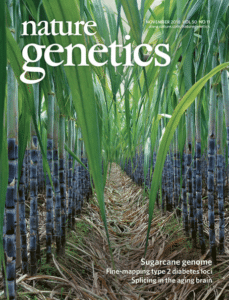 It took nearly 20 years until the technology was right, and five years of hard graft by more than 100 scientists from 16 institutions, but the result was worth it, according to University of Illinois plant biology professor Ray Ming.
It took nearly 20 years until the technology was right, and five years of hard graft by more than 100 scientists from 16 institutions, but the result was worth it, according to University of Illinois plant biology professor Ray Ming.
One of several authors of a paper published and featured on the cover of Nature Genetics reporting the assembly of a 3.13 Gb reference genome of the incredibly complex autopolyploid sugarcane Saccharum spontaneum L, Ming said he dreamed about having a reference genome for sugarcane while working on sugarcane genome mapping in the late 1990s.
But sequencing technology was not ready to handle large autopolyploid genomes until 2015, when the throughput, read length, and cost of long-read SMRT Sequencing by PacBio became competitive enough, he said.
The Saccharum spontaneum AP85-441 contig-level assembly incorporated sequencing data from a mixture of sequencing technologies, including BAC pools sequenced with short reads and whole-genome shotgun SMRT Sequencing.
Additional mapping using Hi-C allowed the team to dissect genetic information from all four haplotypes that make up the sugarcane hybrid currently used in the field, which combines Saccharum officinarum (desirable for its high sugar content) and Saccharum spontaneum (desirable for its hardiness and disease resistance).
Evolutionary changes which resulted in double duplication of the hybrid genome created additional technical challenges, quadrupling the size of the genome and introducing repeat elements that were difficult to parse out among the four haplotypes.
“By combining long sequence reads and the Hi-C physical map, we assembled an autotetraploid genome into 32 chromosomes and realized our goal of allele-specific annotation among homologous chromosomes,” Ming said.
The new assembly has already provided insights into the hybrid’s evolution as well as characteristics of its parent lines, information that could help breeders to mine effective alleles of disease resistance and other desirable traits into future molecular breeding efforts.
“This reference genome offers substantial new knowledge and unprecedented genomic resources for sugarcane breeders and researchers to mine disease resistance and other alleles in rearranged chromosomes from historic hybrid cultivars, and to track them in breeding populations to shorten the 13-year breeding cycle,” the authors wrote.
December 13, 2018 | Agrigenomics